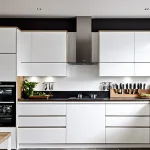Actionable Strategies to Enhance Kitchen Workflow Efficiency
Improving kitchen productivity strategies begins with designing a systematic kitchen layout that supports seamless movement. Organizing stations logically—placing prep, cooking, and plating areas in order—reduces unnecessary steps. This is particularly vital in UK restaurant operations, where space constraints often intensify workflow challenges.
Another key technique involves process mapping. By charting each task, chefs and managers can identify bottlenecks and optimize time use. For instance, introducing standardized routines—like prepping ingredients in bulk during off-peak hours—can significantly cut down wait times and enhance overall workflow efficiency.
This might interest you : Key elements for crafting a contemporary uk kitchen design
Addressing bottlenecks unique to UK restaurants means recognizing factors like varying staff skill levels and fluctuating customer volumes. Flexible deployment of team members during rush hours or rotating duties reduces strain and maintains consistent output quality.
Implementing these strategies fosters a streamlined kitchen environment, which boosts productivity and supports better service delivery. Embracing a methodical approach to kitchen workflow is an investment that UK restaurants can’t afford to overlook.
In the same genre : Blending heritage and innovation: the evolution of uk kitchen bars
Best Practices for Kitchen Layout Optimization
Optimizing kitchen layout design begins with tailoring station setups to match the specific menu and team roles. Each workstation should be organized for the tasks assigned, ensuring that chefs, prep staff, and servers move smoothly without unnecessary overlap. This targeted organization enhances efficiency and reduces downtime in a busy commercial kitchen.
Effective workspace optimisation also involves maximising available space while complying with UK safety standards. Adequate clearance between stations, proper ventilation, and clear access routes prevent accidents and facilitate quick responses during peak hours. Ignoring these details can create bottlenecks that disrupt the whole workflow.
In addition, integrating flexible modular equipment is vital for adapting to evolving menu demands and team dynamics. Modular units can be rearranged or expanded, promoting a versatile commercial kitchen workflow. This adaptability means kitchens can respond swiftly to market trends or seasonal menu changes without a costly overhaul.
By focusing on these core elements—station-specific layouts, compliant space utilisation, and modular flexibility—commercial kitchens can maintain seamless operations and improve overall productivity. Such strategic planning ultimately supports both staff efficiency and food quality.
Staff Training and Team Communication
Effective kitchen staff training directly impacts teamwork and overall restaurant productivity UK-wide. Prioritising continuous skills development enhances staff efficiency, reduces errors, and promotes a smoother workflow. Training should emphasize not just individual proficiency but also how each role interconnects within the team to maintain pace during busy service hours.
Clear communication protocols are vital, especially in the fast-moving environment of UK restaurants. These protocols allow staff to anticipate needs, swiftly resolve issues, and maintain customer satisfaction. For instance, employing standardized terminology for orders and kitchen tasks helps minimise confusion.
Pre-shift briefings set the tone by outlining daily priorities, potential challenges, and delegate responsibilities, ensuring everyone understands their role before service begins. Similarly, post-service reviews encourage staff to reflect on what went well and what could be improved. This cycle supports a culture of continuous learning and adaptability, essential for maximising restaurant productivity UK-wide.
Implementing such practices transforms kitchen staff training from a one-off activity into an ongoing process that strengthens teamwork and operational efficiency seamlessly.
Leveraging Technology to Streamline Operations
In today’s competitive restaurant landscape, kitchen technology transforms daily workflows, enhancing speed and accuracy. One effective tool is the kitchen display system (KDS), which replaces traditional paper tickets with digital screens, reducing errors and improving communication between front and back of house. Automated ordering systems complement this by seamlessly transmitting customer requests, boosting efficiency and customer satisfaction.
Utilising restaurant management systems UK offers deeper benefits beyond order facilitation. Inventory management software tracks stock in real time, helping businesses reduce waste and order supplies precisely when needed. Meanwhile, scheduling software aligns staff shifts with peak hours, optimising labour costs and ensuring smooth operations.
UK restaurants increasingly adopt these digital tools to stay agile. Notably, establishments that integrate kitchen technology with management systems see measurable improvements in turnaround times and cost control. For example, venues leveraging interconnected platforms often report smoother coordination, quicker service, and heightened profitability. Understanding local trends, such as prioritising cloud-based solutions for remote oversight, allows operators to tailor technology investments effectively. Embracing these advancements unlocks substantial operational gains while adapting to the distinct needs of UK restaurant environments.
Quick-Start Checklists and Compliance Tips for Immediate Gains
Optimising your kitchen starts with practical kitchen efficiency tips designed for UK restaurants, focusing on both productivity and compliance. Begin with a straightforward checklist: ensure food storage temperatures are consistently monitored, implement clear labeling systems, and maintain equipment cleanliness daily. These steps not only boost efficiency but also support adherence to UK health and safety regulations.
For compliance, regularly verify that fire safety equipment is functional and correctly positioned. Conduct daily risk assessments to identify hazards, and keep training records updated to meet labour standards. Simple yet effective, these compliance checks reduce the risk of violations and enhance workplace safety.
To maintain smooth operations, access resources such as the Health and Safety Executive guidelines and industry-specific compliance toolkits. Embedding these regulatory compliance practices into daily routines ensures ongoing adherence and operational support. By systematically following these practical steps, restaurant managers can achieve immediate improvements in both productivity and safety, fostering a compliant and efficient kitchen environment.

